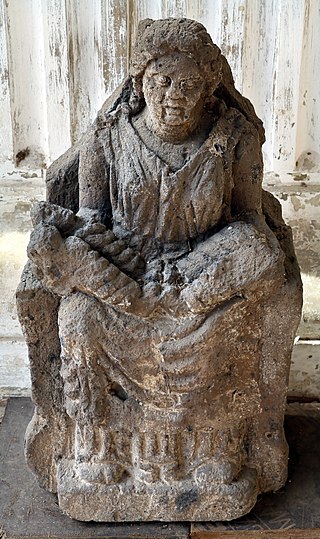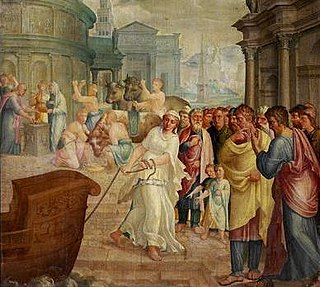Description
The temple was 33.18 metres deep, and its frontage 17.10 metres wide, accessed by steps of the same width. It was built in the prostyle hexastyle of the Corinthian order. The whole was supported by a massively walled, stucco-faced podium of irregular, thickly mortared tufa and peperino. A coin of Faustina the Elder is thought to show the same temple, with curved roof and a flight of steps.
At the top of the steps is a statue of Cybele enthroned, with a turreted crown and lion attendants. This is consistent with a colossal, fragmentary statue of the goddess, found within the temple precincts. The goddess' meteoric stone may have been kept on a pedestal within the temple cella; or incorporated into the face of a statue and set on a pediment. [4] This stone was known as the acus Matris Deum or the needle of Cybele, described by Servius as being "conical in shape, of a deep brown color" with the appearance of molten rock and sharp to a point. [5] This acus is identified by Servius as a pignora imperii , one of the seven sacred objects which maintained imperial rule. [6]
The temple pediment is shown on the Ara Pietatis relief, which represents Magna Mater in aniconic mode; her empty throne and crown are flanked by two figures of Attis reclining on tympanons; and by two lions who eat from bowls, as if tamed by the goddess' unseen presence. [7]
The temple remained in use until the late 4th century. It was destroyed in 394 AD, on the orders of Emperor Theodosius I during the Persecution of pagans in the late Roman Empire.

Venus is a Roman goddess whose functions encompass love, beauty, desire, sex, fertility, prosperity, and victory. In Roman mythology, she was the ancestor of the Roman people through her son, Aeneas, who survived the fall of Troy and fled to Italy. Julius Caesar claimed her as his ancestor. Venus was central to many religious festivals, and was revered in Roman religion under numerous cult titles.

Proserpina or Proserpine is an ancient Roman goddess whose iconography, functions and myths are virtually identical to those of Greek Persephone. Proserpina replaced or was combined with the ancient Roman fertility goddess Libera, whose principal cult was housed in the Aventine temple of the grain-goddess Ceres, along with the wine god Liber.

The Ides of March is the day on the Roman calendar marked as the Idus, roughly the midpoint of a month, of Martius, corresponding to 15 March on the Gregorian calendar. It was marked by several major religious observances. In 44 BC, it became notorious as the date of the assassination of Julius Caesar, which made the Ides of March a turning point in Roman history.

Vesta is the virgin goddess of the hearth, home, and family in Roman religion. She was rarely depicted in human form, and was more often represented by the fire of her temple in the Forum Romanum. Entry to her temple was permitted only to her priestesses, the Vestal Virgins. Their virginity was deemed essential to Rome's survival; if found guilty of inchastity, they were buried or entombed alive. As Vesta was considered a guardian of the Roman people, her festival, the Vestalia, was regarded as one of the most important Roman holidays. During the Vestalia privileged matrons walked barefoot through the city to the temple, where they presented food-offerings. Such was Vesta's importance to Roman religion that following the rise of Christianity, hers was one of the last non-Christian cults still active, until it was forcibly disbanded by the Christian emperor Theodosius I in AD 391.

Cybele is an Anatolian mother goddess; she may have a possible forerunner in the earliest neolithic at Çatalhöyük. She is Phrygia's only known goddess, and likely, its national deity. Greek colonists in Asia Minor adopted and adapted her Phrygian cult and spread it to mainland Greece and to the more distant western Greek colonies around the sixth century BC.

In ancient Roman religion, Ceres was a goddess of agriculture, grain crops, fertility and motherly relationships. She was originally the central deity in Rome's so-called plebeian or Aventine Triad, then was paired with her daughter Proserpina in what Romans described as "the Greek rites of Ceres". Her seven-day April festival of Cerealia included the popular Ludi Ceriales. She was also honoured in the May lustration (lustratio) of the fields at the Ambarvalia festival: at harvesttime: and during Roman marriages and funeral rites. She is usually depicted as a mature woman.

In Greek mythology, the satyr Marsyas is a central figure in two stories involving music: in one, he picked up the double oboe (aulos) that had been abandoned by Athena and played it; in the other, he challenged Apollo to a contest of music and lost his hide and life. Literary sources from antiquity often emphasize the hubris of Marsyas and the justice of his punishment.

A gallus was a eunuch priest of the Phrygian goddess Cybele and her consort Attis, whose worship was incorporated into the state religious practices of ancient Rome.
Bona Dea was a goddess in ancient Roman religion. She was associated with chastity and fertility among married Roman women, healing, and the protection of the state and people of Rome. According to Roman literary sources, she was brought from Magna Graecia at some time during the early or middle Republic, and was given her own state cult on the Aventine Hill.

Mater Matuta was an indigenous Latin goddess, whom the Romans eventually made equivalent to the dawn goddess Aurora and the Greek dawn goddess Eos. Mater Matuta was the goddess of female maturation, and later became linked to the dawn. Her cult is attested to in several places in Latium; her most famous temple was located at Satricum.

In ancient Roman religion Victoria was the deified personification of victory. She first appears during the first Punic War, seemingly as a Romanised re-naming of Nike, the goddess of victory associated with Rome's Greek allies in the Greek mainland and in Magna Graecia. Thereafter she comes to symbolise Rome's eventual hegemony and right to rule. She is a deified abstraction, entitled to a cult. But unlike Nike, she has virtually no mythology of her own.
The Sibylline Books were a collection of oracular utterances, set out in Greek hexameter verses, that, according to tradition, were purchased from a sibyl by the last king of Rome, Lucius Tarquinius Superbus, and consulted at momentous crises through the history of the Roman Republic and the Empire.

Juno was an ancient Roman goddess, the protector and special counsellor of the state. She was equated to Hera, queen of the gods in Greek mythology and a goddess of love and marriage. A daughter of Saturn and Ops, she was the sister and wife of Jupiter and the mother of Mars, Vulcan, Bellona, Lucina and Juventas. Like Hera, her sacred animal was the peacock. Her Etruscan counterpart was Uni, and she was said to also watch over the women of Rome. As the patron goddess of Rome and the Roman Empire, Juno was called Regina ("Queen") and was a member of the Capitoline Triad, centered on the Capitoline Hill in Rome, and also including Jupiter, and Minerva, goddess of wisdom.
Catullus 63 is a Latin poem of 93 lines in galliambic metre by the Roman poet Catullus.
A number of temples to Cybele in Rome have been identified. Originally an Anatolian mother goddess, the cult of Cybele was formally brought to Rome during the Second Punic War after a consultation with the Sibylline Books.

Quinta Claudia was a Roman matron said to have been instrumental in bringing the goddess Cybele, "Great Mother" of the gods from her shrine in Greek Asia Minor to Rome in 204 BC, during the last years of Rome's Second Punic War against Carthage. The goddess had been brought in response to dire prodigies, a failed harvest and the advice of various oracles. Roman histories and stories describe Quinta Claudia as castissima femina in Rome, chosen along with Scipio Nasica, Rome's optimus vir to welcome the goddess.
The Megalesia, Megalensia, or Megalenses Ludi was a festival celebrated in ancient Rome from April 4 to April 10, in honour of Cybele, whom the Romans called Magna Mater. The name of the festival derives from Greek megalē (μϵγάλη), meaning "great". The festival was one of several on the Roman calendar celebrated with ludi, games and performances.

In ancient Greece and Rome, the tympanon (τύμπανον) or tympanum, was a type of frame drum or tambourine. It was circular, shallow, and beaten with the palm of the hand or a stick. Some representations show decorations or zill-like objects around the rim. The instrument was played by worshippers in the rites of Dionysus, Cybele, and Sabazius.
The pignora imperii were objects that were supposed to guarantee the continued imperium of Ancient Rome. One late source lists seven. The sacred tokens most commonly regarded as such were:

Venus Verticordia was an aspect of the Roman goddess Venus conceived as having the power to convert either virgins or sexually active women from dissolute desire (libido) to sexual virtue (pudicitia). Under this title, Venus was especially cultivated by married women, and on 1 April she was celebrated at the Veneralia festival with public bathing.

















